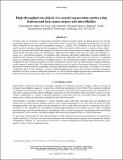High-throughput on-chip in vivo neural regeneration studies usingfemtosecond laser nano-surgery and microfluidics
Author(s)
Samara, Chrysanthi; Gilleland, Cody Lee; Zeng, Fei; Rohde, Christopher Benjamin; Yanik, Mehmet Fatih
DownloadRohde-2009-High-throughput on-chip in vivo neural regeneration studies usingfemtosecond laser nano-surgery and microfluidics.pdf (1.420Mb)
PUBLISHER_POLICY
Publisher Policy
Article is made available in accordance with the publisher's policy and may be subject to US copyright law. Please refer to the publisher's site for terms of use.
Terms of use
Metadata
Show full item recordAbstract
In recent years, the advantages of using small invertebrate animals as model systems for human disease have become increasingly apparent and have resulted in three Nobel Prizes in medicine or chemistry during the last six years for studies conducted on the nematode Caenorhabditis elegans (C. elegans). The availability of a wide array of species-specific genetic techniques, along with the transparency of the worm and its ability to grow in minute volumes make C. elegans an extremely powerful model organism. We present a suite of technologies for complex high-throughput whole-animal genetic and drug screens. We demonstrate a high-speed microfluidic sorter that can isolate and immobilize C. elegans in a well-defined geometry, an integrated chip containing individually addressable screening chambers for incubation and exposure of individual animals to biochemical compounds, and a device for delivery of compound libraries in standard multiwell plates to microfluidic devices. The immobilization stability obtained by these devices is comparable to that of chemical anesthesia and the immobilization process does not affect lifespan, progeny production, or other aspects of animal health. The high-stability enables the use of a variety of key optical techniques. We use this to demonstrate femtosecond-laser nanosurgery and three-dimensional multiphoton microscopy. Used alone or in various combinations these devices facilitate a variety of high-throughput assays using whole animals, including mutagenesis and RNAi and drug screens at subcellular resolution, as well as high-throughput high-precision manipulations such as femtosecond-laser nanosurgery for large-scale in vivo neural degeneration and regeneration studies.
Date issued
2009-02Department
Massachusetts Institute of Technology. Department of Electrical Engineering and Computer Science; Massachusetts Institute of Technology. Research Laboratory of ElectronicsJournal
Proceedings of SPIE--the International Society for Optical Engineering
Publisher
Society of Photo-optical Instrumentation Engineers
Citation
Rohde, Christopher B. et al. “High-throughput on-chip in vivo neural regeneration studies using femtosecond laser nano-surgery and microfluidics.” Commercial and Biomedical Applications of Ultrafast Lasers IX. Ed. Joseph Neev et al. SPIE, 2009. 72030E. © 2009 SPIE
Version: Final published version
ISSN
0277-786X